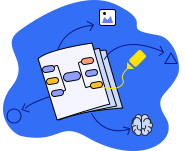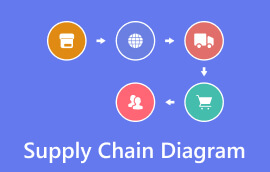Learn Everything about the Six Sigma Tool, along with Its Principles and Application
Are you eager to learn about the Six Sigma Tool? Well, it is a technique to analyze data and can play a role in implementing improvements on a certain project. But that’s not all. It has various principles that focus on solving the problem, finding solutions, focusing on customers, and more. So, if you want to learn more about the Six Sigma tool, the best choice is to read the whole content of this post.

- Part 1. What is Six Sigma
- Part 2. Six Sigma Tools
- Part 3. Six Sigma Principles
- Part 4. How to Apply Six Sigma
- Part 5. FAQs about the Six Sigma Tool
Part 1. What is Six Sigma
The Six Sigma process is a technique and tool for improvement. Motorola developed Six Sigma in the 1980s. Then, it became popular with some companies like General Electric. It also refers to a statistical concept that measures how a process deviates from perfection. In the Six Sigma process, errors or defects occur at a rate of fewer than 3.4 occurrences per million opportunities. Plus, the goal of this process is to develop and improve efficiency. It also reduces defects by identifying, analyzing, and removing the causes of inconsistency and variation in business processes.
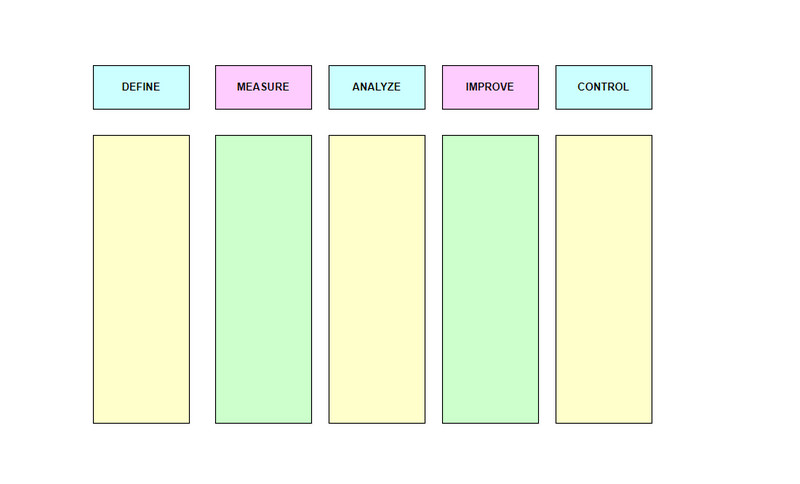
Click here to see the detailed Six Sigma.
Part 2. Six Sigma Tools
The Six Sigma uses various tools and techniques to analyze information. It is also a big help in implementing improvements and identifying root causes. So, if you want to discover various Six Sigma tools, you can see the data below.
1. DMAIC
The DMAIC is a 5-step process. DMAIC is the first and most popular tool in Six Sigma (Define, Measure, Analyze, Improve, and Control). This process helps to improve manufacturing methods. It also comes with the help of measured objectives and data.
2. The 5 Whys
To identify the root causes of problems, using the 5 Whys tool is better. It's deployed as part of the Analyze phase in the first tool.
The 5 Whys work like this:
◆ Write down the problem to focus on.
◆ Ask why the problem or any challenges occurred.
◆ If the first answer is the main cause, ask why again.
◆ Repeat the question five times to identify the real source of the problem.
◆ You can ask more than five times. After that, you will have clarity on the problem.
3. The 5S System
For better management and instant access, the materials are organized using the 5S System.
The 5S System are:
◆ Seiri (Sort) - All extra items must be removed from the production. The most important thing here is leaving essential items.
◆ Seiton (Set in order) - It is about arranging the items and labeling them based on their clutter-free.
◆ Seiso (Shine) - Always make the area clean. It is also recommended to inspect everything regularly.
◆ Seiketsu (Standardize) - Write the standard. Then, sort and set them in order.
◆ Shitsuke (Sustain) - Execute the standards you’ve set for your company and follow them regularly.
4. Value Stream Mapping
It is used under the Analyze phase of DMAIC. It is helpful in optimizing and improving the flow throughout the organization. It also helps identify three things. These are Value-adding activities, Non-value-adding activities, and Value-enabling activities.
5. Regression Analysis
It defines the mathematical relationship of output and input variables. It is also a statistical procedure for understanding and estimating the relationship between the variables. Additionally, it is a method that can determine the extent to which a connection exists between the variables.
6. Pareto Chart
The Pareto Chart shows the relative importance of various problems or issues. It highlights the most significant contributors.
7. FMEA
FMEA is a systematic method for prioritizing and evaluating potential failure modes in a process and assessing their impact.
8. Kaizen
Kaizen signifies ongoing enhancement. It embodies a method that consistently entails the observation, recognition, and execution of incremental improvements within your manufacturing processes.
9. Poka-Yoke
It helps to rectify and identify the errors of the employee throughout the production and manufacturing process.
10. Kanban System
The Kanban system adds efficiency and provides more focus to the business by activating the supply chain when it requires demand. Also, the system helps the business processes by giving limits for inventory holding.
Part 3. Six Sigma Principles
Customer Focus
◆ The main goal is to offer various benefits to customers. Thus, a business must learn the needs of its customers and drivers of sales.
Find A Problem and Assess the Value Chain
◆ Define goals for data collection, expected insights, and purposes for data gathering. Ensure that the data is helping to achieve the main objective of the project. It is also important to find out the main problem and its root cause.
Remove Defects and Outliers
◆ After identifying the problem, make proper modifications in the process to remove defects. Eliminate all defects that have no contribution to the customer value. Also, eliminating the outliers and defects erases the hindrances in the process.
Involve Stakeholder
◆ A systematic approach should be embraced, encouraging active collaboration among all stakeholders to collectively address issues. The team must attain expertise in the methodologies and principles applied during this process.
Flexible and Responsive System
◆ A flexible and responsive environment can lead to the efficient implementation of the projects.
Part 4. How to Apply Six Sigma
The Six Sigma process uses a structured approach. It is referred to as DMAIC (Define, Measure, Analyze, Improve, Control). If you want to know more, see below the Six Sigma steps.
Define
◆ It articulates the problem clearly. It is also about the opportunity for improvement, defining the project’s scope and the project’s goal.
Measure
◆ The team measures the primary performance of the process. Also, it is about collecting relevant information to identify the root causes of defects. The efficiency of the process is also included.
Analyze
◆ The next phase is Analyze. It is about analyzing the process by isolating each input. It also discusses the potential reason for any failures.
Improve
◆ This phase or step is about implementing changes to the process. Its goal is to eliminate and address the root causes identified in the Analyze phase.
Control
◆ Establish controls to make sure that the improvements made are sustained over time. This phase involves monitoring the process and putting measures in place. This way, it can prevent a return to the previous state.
If you want to create a diagram for your project, use the MindOnMap. Creating a diagram is easy when using the tool. It is because it has an intuitive user interface that allows all users to navigate. Also, the tool can offer various functions to use to get your desired outcome. You can use various font styles, lines, shapes, colors, and more. With that, you can create a simple yet colorful diagram. Moreover, you can access the MindOnMap on both offline and online platforms. So, if you want to use the tool on your computer or browser, this is the perfect tool to use. Now, if you want to learn the easy ways to conduct the Six Sigma, let’s see the methods below.
Create your MindOnMap account from your browser. After that, wait a moment to load its main webpage.
Secure Download
Secure Download

From the web page, there are various sections you will encounter on your screen. Navigate to the left screen and choose the New button. After clicking, you will see different functions and templates to use. To see the tool’s interface, select the Flowchart function.
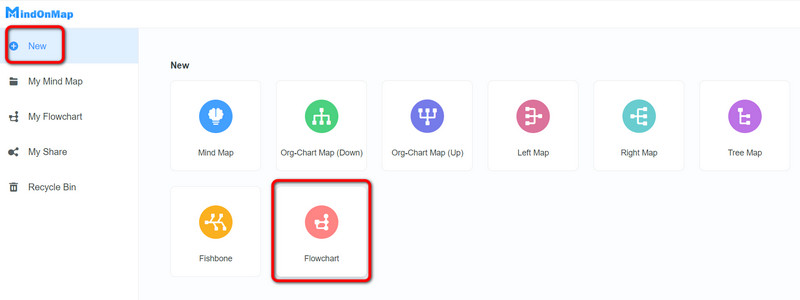
This time, you can start creating an amazing diagram. Well, if you want to start inserting shapes, go to the General option from the left screen. You can also use advanced shapes from other sections, such as Flowchart, Advanced, Misc, Basic, etc. To add more flavor, you can use some functions from the top interface.
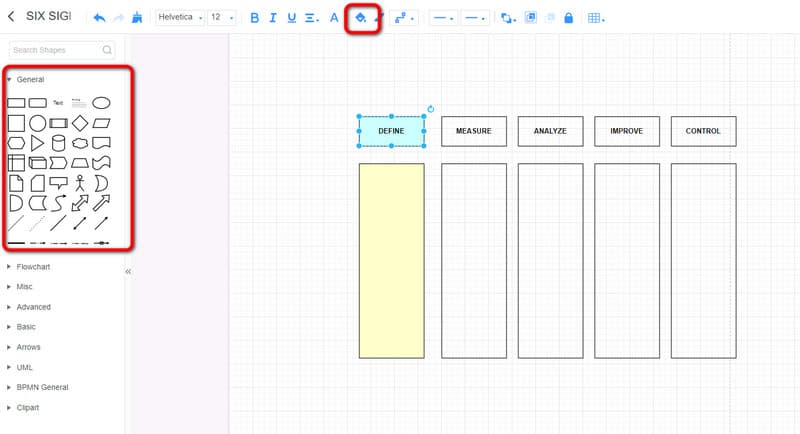
After the creation process, you can begin the Saving procedure. To do so, you can simply click the Save button from the top interface. Once done, the final output will be saved on your MindOnMap account.
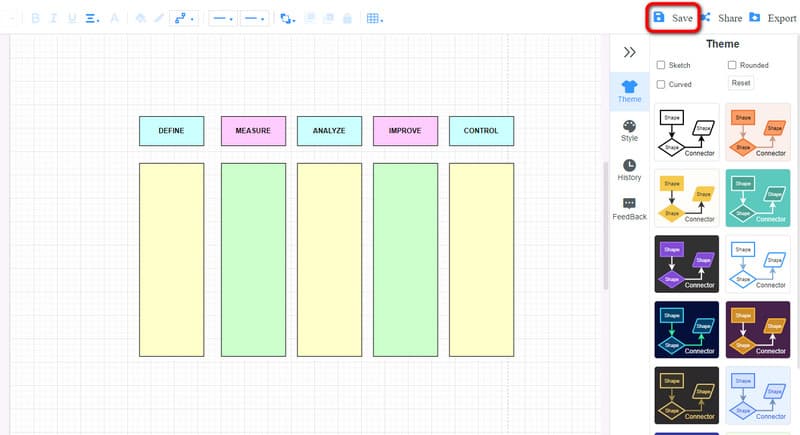
Part 5. FAQs about the Six Sigma Tool
What are the 6 points of Six Sigma?
The six points capture the importance of Six Sigma. These are customer focus, data-driven decision-making, process improvement, proactive management, employee involvement, and a commitment to achieving high levels of quality and efficiency.
What is Six Sigma in simple terms?
To make it simple, Six Sigma is a tool and technique for process improvement. Its main objective is to eliminate defects or errors in a process.
Is Sigma Six worth it?
Yes, it is. But it also depends on the specific content and objective of a company or organization. It is beneficial for businesses, leading to the improvement of efficiency, customer satisfaction, quality, and overall performance.
Conclusion
Those 10 Six Sigma tools introduced above can help you improve the business processes. That is the reason why the post gives you enough information about Six Sigma, including its principles and other information. In addition to that, conducting a Six Sigma technique is simple when using the right tool, like MindOnMap. So, feel free to use the software and begin your journey in creating the best diagram online and offline.







